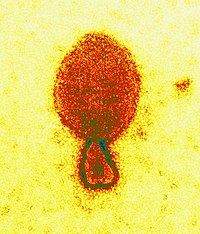
Photo from wikipedia
Diphenyleneiodonium (DPI) and N-acetyl-l-cysteine (NAC), two widely used anti-oxidants, were employed to evaluate the role of oxidative stress in Japanese encephalitis virus (JEV) induced autophagy, stress responses and replication. DPI… Click to show full abstract
Diphenyleneiodonium (DPI) and N-acetyl-l-cysteine (NAC), two widely used anti-oxidants, were employed to evaluate the role of oxidative stress in Japanese encephalitis virus (JEV) induced autophagy, stress responses and replication. DPI and NAC exerted opposite effects on ROS levels in JEV infected mouse neuronal cells (Neuro2a), mouse embryonic fibroblasts (MEFs) and human epithelial cells (HeLa). While NAC effectively quenched ROS, DPI enhanced ROS levels, suggesting that DPI induces oxidative stress in JEV infected cells. DPI treatment of JEV infected Neuro2a cells further blocked autophagy induction and activation of all three arms of the ER stress pathway, and, inhibited virus particle release. Autophagy induction in JEV infection has been previously shown to be linked to the activation of XBP1 and ATF6 ER stress sensors. Our data suggests that DPI mediated block of autophagy is a result of inhibition of ER stress responses and is not associated with an anti-oxidative effect. Since DPI has a wide inhibitory potential for all Flavin dependent enzymes, it is likely that the signalling pathways for ER stress and autophagy during JEV infection are modulated by DPI sensitive enzymes.
Journal Title: Biochemical and biophysical research communications
Year Published: 2018
Link to full text (if available)
Share on Social Media: Sign Up to like & get
recommendations!